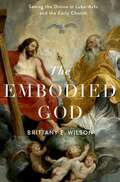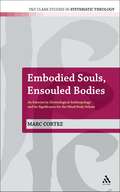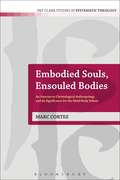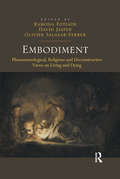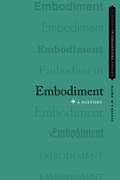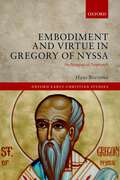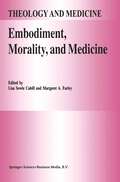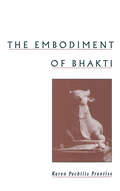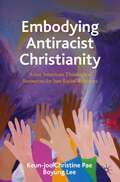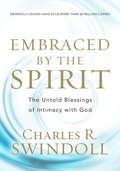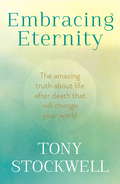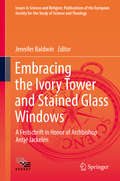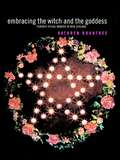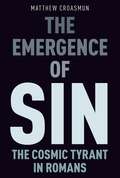- Table View
- List View
The Embodied God: Seeing the Divine in Luke-Acts and the Early Church
by Brittany E. WilsonAs inheritors of Platonic traditions, many Jews and Christians today do not believe that God has a body. God is instead invisible and incorporeal, and even though Christians believe that God can be seen in Jesus, God otherwise remains veiled from human sight. In this ground-breaking work, Brittany E. Wilson challenges this prevalent view by arguing that early Jews and Christians often envisioned God as having a visible form. Within the New Testament, Luke-Acts in particular emerges as an important example of a text that portrays God in visually tangible ways. According to Luke, God is a perceptible, concrete being who can take on a variety of different forms, as well as a being who is intimately intertwined with human fleshliness in the form of Jesus. In this way, the God of Israel does not adhere to the incorporeal deity of Platonic philosophy, especially as read through post-Enlightenment eyes. Given the corporeal connections between God and Jesus, Luke's depiction of Jesus's body also points ahead to future controversies concerning his divinity and humanity in the early church. Indeed, questions concerning God's body are inextricably linked with Christology and shed light on how we are to understand Jesus's own visible embodiment in relation to God. In The Embodied God, Wilson reframes approaches to early Christology within New Testament scholarship and calls for a new way of thinking about divine-and human-bodies and embodied experience.
Embodied Souls, Ensouled Bodies: An Exercise in Christological Anthropology and Its Significance for the Mind/Body Debate (T&T Clark Studies in Systematic Theology)
by Marc CortezThe book explores the relationship between Christology and theological anthropology through the lens provided by the theology of Karl Barth and the mind/body discussion in contemporary philosophy of mind. It thus comprises two major sections. The first develops an understanding of Karl Barth's theological anthropology focusing on three major facets: (1) the centrality of Jesus Christ for any real understanding of human persons; (2) the resources that such a christologically determined view of human nature has for engaging in interdisciplinary discourse; and (3) the ontological implications of this approach for understanding the mind/body relationship. The second part draws on this theological foundation to consider the implications that Christological anthropology has for analyzing and assessing several prominent ways of explaining the mind/body relationship. Specifically, it interacts with two broad categories of theories: 'nonreductive' forms of physicalism and 'holistic' forms of dualism. After providing a basic summary of each, the book applies the insights gained from Barth's anthropology to ascertain the extent to which the two approaches may be considered christologically adequate.
Embodied Souls, Ensouled Bodies: An Exercise in Christological Anthropology and Its Significance for the Mind/Body Debate (T&T Clark Studies in Systematic Theology)
by Marc CortezThe book explores the relationship between Christology and theological anthropology through the lens provided by the theology of Karl Barth and the mind/body discussion in contemporary philosophy of mind. It thus comprises two major sections. The first develops an understanding of Karl Barth's theological anthropology focusing on three major facets: (1) the centrality of Jesus Christ for any real understanding of human persons; (2) the resources that such a christologically determined view of human nature has for engaging in interdisciplinary discourse; and (3) the ontological implications of this approach for understanding the mind/body relationship. The second part draws on this theological foundation to consider the implications that Christological anthropology has for analyzing and assessing several prominent ways of explaining the mind/body relationship. Specifically, it interacts with two broad categories of theories: 'nonreductive' forms of physicalism and 'holistic' forms of dualism. After providing a basic summary of each, the book applies the insights gained from Barth's anthropology to ascertain the extent to which the two approaches may be considered christologically adequate.
Embodiment: Phenomenological, Religious and Deconstructive Views on Living and Dying
by Ramona Fotiade David Jasper Olivier Salazar-FerrerThis book examines a number of landmark shifts in our account of the relationship between human and divine existence, as reflected through the perception of time and corporeal experience. Drawing together some of the best scholars in the field, this book provides a representative cross-section of influential trends in the philosophy of religion (e.g. phenomenology, existential thought, Biblical hermeneutics, deconstruction) that have shaped our understanding of the body in its profane and sacred dimensions as site of conflicting discourses on presence and absence, subjectivity and the death of the subject, mortality, resurrection and eternal life.
Embodiment: Phenomenological, Religious and Deconstructive Views on Living and Dying
by Ramona Fotiade David Jasper Olivier Salazar-FerrerThis book examines a number of landmark shifts in our account of the relationship between human and divine existence, as reflected through the perception of time and corporeal experience. Drawing together some of the best scholars in the field, this book provides a representative cross-section of influential trends in the philosophy of religion (e.g. phenomenology, existential thought, Biblical hermeneutics, deconstruction) that have shaped our understanding of the body in its profane and sacred dimensions as site of conflicting discourses on presence and absence, subjectivity and the death of the subject, mortality, resurrection and eternal life.
Embodiment: A History (Oxford Philosophical Concepts)
by Justin E. H. SmithEmbodiment--defined as having, being in, or being associated with a body--is a feature of the existence of many entities, perhaps even of all entities. Why entities should find themselves in this condition is the central concern of the present volume. The problem includes, but also goes beyond, the philosophical problem of body: that is, what the essence of a body is, and how, if at all, it differs from matter. On some understandings there may exist bodies, such as stones or asteroids, that are not the bodies of any particular subjects. To speak of embodiment by contrast is always to speak of a subject that variously inhabits, or captains, or is coextensive with, or even is imprisoned within, a body. The subject may in the end be identical to, or an emergent product of, the body. That is, a materialist account of embodied subjects may be the correct one. But insofar as there is a philosophical problem of embodiment, the identity of the embodied subject with the body stands in need of an argument and cannot simply be assumed. The reasons, nature, and consequences of the embodiment of subjects as conceived in the long history of philosophy in Europe as well as in the broader Mediterranean region and in South and East Asia, with forays into religion, art, medicine, and other domains of culture, form the focus of these essays. More precisely, the contributors to this volume shine light on a number of questions that have driven reflection on embodiment throughout the history of philosophy. What is the historical and conceptual relationship between the idea of embodiment and the idea of subjecthood? Am I who I am principally in virtue of the fact that I have the body I have? Relatedly, what is the relationship of embodiment to being and to individuality? Is embodiment a necessary condition of being? Of being an individual? What are the theological dimensions of embodiment? To what extent has the concept of embodiment been deployed in the history of philosophy to contrast the created world with the state of existence enjoyed by God? What are the normative dimensions of theories of embodiment? To what extent is the problem of embodiment a distinctly western preoccupation? Is it the result of a particular local and contingent history, or does it impose itself as a universal problem, wherever and whenever human beings begin to reflect on the conditions of their existence? Ultimately, to what extent can natural science help us to resolve philosophical questions about embodiment, many of which are vastly older than the particular scientific research programs we now believe to hold the greatest promise for revealing to us the bodily basis, or the ultimate physical causes, of who we really are?
Embodiment And Virtue In Gregory Of Nyssa: An Anagogical Approach (Oxford Early Christian Studies)
by Hans BoersmaEmbodiment in the theology of Gregory of Nyssa is a much-debated topic. Hans Boersma argues that this-worldly realities of time and space, which include embodiment, are not the focus of Gregory's theology. Instead, embodiment plays a distinctly subordinate role. The key to his theology, Boersma suggests, is anagogy, going upward in order to participate in the life of God. This book looks at a variety of topics connected to embodiment in Gregory's thought: time and space; allegory; gender, sexuality, and virginity; death and mourning; slavery, homelessness, and poverty; and the church as the body of Christ. In each instance, Boersma maintains, Gregory values embodiment only inasmuch as it enables us to go upward in the intellectual realm of the heavenly future. Boersma suggests that for Gregory embodiment and virtue serve the anagogical pursuit of otherworldly realities. Countering recent trends in scholarship that highlight Gregory's appreciation of the goodness of creation, this book argues that Gregory looks at embodiment as a means for human beings to grow in virtue and so to participate in the divine life. It is true that, as a Christian thinker, Gregory regards the creator-creature distinction as basic. But he also works with the distinction between spirit and matter. And Nyssen is convinced that in the hereafter the categories of time and space will disappear-while the human body will undergo an inconceivable transformation. This book, then, serves as a reminder of the profoundly otherworldly cast of Gregory's theology.
Embodiment, Morality, and Medicine (Theology and Medicine #6)
by Margaret A. Farley Lisa SowleCahillEmbodiment, Morality and Medicine deals with the relevance of `embodiment' to bioethics, considering both the historical development and contemporary perspectives on the mind--body relation. The emphasis of all authors is on the importance of the body in defining personal identity as well as on the role of social context in shaping experience of the body. Among the perspectives considered are Christian, Jewish, Islamic, Buddhist, and African-American. Feminist concerns are important throughout.
The Embodiment of Bhakti
by Karen Pechilis PrentissThis book offers an interpretive history of bhakti, an influential religious perspective in Hinduism. Prentiss argues that although bhakti is mentioned in every contemporary sourcebook on Indian religions, it still lacks an agreed-upon definition. "Devotion" is found to be the most commonly used synonym. Prentiss seeks a new perspective on this elusive concept. Her analysis of Tamil (south Indian) materials leads her to suggest that bhakti be understood as a doctrine of embodiment. Bhakti, she says, urges people towards active engagement in the worship of God. She proposes that the term "devotion" be replaced by "participation," emphasizing bhakti's call for engagement in worship and the necessity of embodiment to fulfill that obligation.
EMBODIMENT OPC C: A History (Oxford Philosophical Concepts)
by Justin E. H. SmithEmbodiment--defined as having, being in, or being associated with a body--is a feature of the existence of many entities, perhaps even of all entities. Why entities should find themselves in this condition is the central concern of the present volume. The problem includes, but also goes beyond, the philosophical problem of body: that is, what the essence of a body is, and how, if at all, it differs from matter. On some understandings there may exist bodies, such as stones or asteroids, that are not the bodies of any particular subjects. To speak of embodiment by contrast is always to speak of a subject that variously inhabits, or captains, or is coextensive with, or even is imprisoned within, a body. The subject may in the end be identical to, or an emergent product of, the body. That is, a materialist account of embodied subjects may be the correct one. But insofar as there is a philosophical problem of embodiment, the identity of the embodied subject with the body stands in need of an argument and cannot simply be assumed. The reasons, nature, and consequences of the embodiment of subjects as conceived in the long history of philosophy in Europe as well as in the broader Mediterranean region and in South and East Asia, with forays into religion, art, medicine, and other domains of culture, form the focus of these essays. More precisely, the contributors to this volume shine light on a number of questions that have driven reflection on embodiment throughout the history of philosophy. What is the historical and conceptual relationship between the idea of embodiment and the idea of subjecthood? Am I who I am principally in virtue of the fact that I have the body I have? Relatedly, what is the relationship of embodiment to being and to individuality? Is embodiment a necessary condition of being? Of being an individual? What are the theological dimensions of embodiment? To what extent has the concept of embodiment been deployed in the history of philosophy to contrast the created world with the state of existence enjoyed by God? What are the normative dimensions of theories of embodiment? To what extent is the problem of embodiment a distinctly western preoccupation? Is it the result of a particular local and contingent history, or does it impose itself as a universal problem, wherever and whenever human beings begin to reflect on the conditions of their existence? Ultimately, to what extent can natural science help us to resolve philosophical questions about embodiment, many of which are vastly older than the particular scientific research programs we now believe to hold the greatest promise for revealing to us the bodily basis, or the ultimate physical causes, of who we really are?
Embodying Antiracist Christianity: Asian American Theological Resources for Just Racial Relations
by Keun-joo Christine Pae Boyung LeeAt a moment of notably rising levels of anti-Asian hate, this book offers antiracist resources informed by Asian/North American feminist theology and biblical scholarship. Although there exist scholarly books and articles on Asian American theology (broadly defined) have proliferated in response to the current ethical, political, and cultural environment have been prolific, there have been few concerted efforts to interrogate or dismantle anti-Asian racism inseparable from anti-black racism, and white settler colonialism that have often undermined the communal spirit and livelihood of Christian churches in the current political climate. In the current political climate, COVID-related anti-Asian hate and racial conflict, which all intersect with gender and sexuality-based violence, require theological, moral, and political inquiries. Hence, this book notes the current paucity of work with critical discussions on the multiple facets of racism from Asian American feminist theological perspectives. Contributors deepen the inter/transdisciplinary approaches concerning how to dismantle racist theological teachings, biblical interpretations, liturgical presentations, and the Christian church’s leadership structure.
Embrace Tiger, Return to Mountain: The Essence of Tai Ji (PDF)
by Chungliang Al Huang'To work with Al Huang is to learn to move with wind and water... in the course of everyday life... a truly superior and gifted teacher who works upon others as the sun and rain upon plants.' - From the foreword by Alan Watts, one of the great writers of Comparative Philosophy and Religion and Taoist and Zen literature. First published in 1973, this all time classic of Tai Ji literature remains as fresh and illuminating today as when it was first published. Written with true passion and eloquence, the book richly conveys the subtle yet profound principles underlying Tai Ji. Movement, stillness, joyfulness, and the ability to live in the moment are the threads running through the text, as well as the humor and compassion to acknowledge the impossibility of human perfection. Containing the original foreword by Alan Watts, the book is illustrated with beautiful calligraphy by the author, and photographs by Si Chi Ko, one of China's "National Treasures". This timeless masterpiece is essential reading for anybody interested in Taoism, Tai Ji, or the Tao philosophy of "Living Our Own Tao", and the author is a wonderful, dramatic, and inspiring presence throughout the book.
Embraced by the Spirit: The Untold Blessings of Intimacy with God
by Charles R. SwindollWorthy Publishing re-releases this classic inspirational work on the Holy Spirit, helping readers experience all the blessings God has in store. This book is the result of Swindoll's 50-plus years in ministry and his lifetime journey of walking with the Holy Spirit.
Embracing Eternity
by Tony StockwellTop TV psychic Tony Stockwell brings us more incredible stories of life after death, as well as inspirational advice on how to channel the power of the spirit realm.Tony's work brings him into contact with people from all over the world who look to him for insight into the continuing existence of their departed loved ones. His awesome abilities to connect with the spirits are truly inspirational and in Embracing Eternity, the follow up to his hugely successful memoir Spirited, he shares those stories of connection and comfort. There are also fascinating case studies showcasing Tony's techniques and advice on how we can all embrace our latent powers to explore the spirit realms. Moving and awe-inspiring, this is a fascinating glimpse of the world beyond the grave.
Embracing the Ivory Tower and Stained Glass Windows: A Festschrift in Honor of Archbishop Antje Jackelén (Issues in Science and Religion: Publications of the European Society for the Study of Science and Theology #2)
by Jennifer BaldwinThis book brings together contributions from scholars from Europe and the United States to honor the theological work of Antje Jackelén, the first female Archbishop of the Church of Sweden. In Archbishop Antje Jackelén’s installation homily, she identifies the strength of the Church as a “global network of prayer threads.” This book is an honorary and celebratory volume providing a “global network of prayerful essays” by contributors from a variety of academic disciplines to creatively engage, reflect, and illuminate the theological work of Archbishop Jackelén. Prior to her tenure in the Church of Sweden as Bishop of the Diocese of Lund and now the Archbishop of the Church of Sweden, Jackelén served as professor of Systematic Theology, Director of the Zygon Center and President of European Society for the Study of Science and Religion (ESSSAT). While each essay intentionally embraces the theological and ministerial work of Jackelén during her academic tenure, they also venture into areas as diverse as climate change, media studies, human uniqueness, hermeneutics, time, ethics, Christian theological tradition and history, traumatology, politics and society. As the first diverse explication of the theological thinking of Archbishop Jackelén by her theological colleagues, this text provides scholars with an expansion of the scope of Archbishop Jackelén’s theological thinking and initiates laity into the impact of Jackelén thinking that combines with grace and precision the traditions of the Church, the challenges and gifts of the sciences, and the needs and longings of society and the world.
Embracing the Witch and the Goddess: Feminist Ritual-Makers in New Zealand
by Kathryn RountreeEmbracing the Witch and the Goddess is a detailed survey of present-day feminist witches in New Zealand. It examines the attraction of witchcraft for its practitioners, and explores witches' rituals, views and beliefs about how magic works. The book provides a detailed portrait of an undocumented section of the growing neo-pagan movement, and compares the special character of New Zealand witchcraft with its counterparts in the United States, Great Britain, and Australia.Kathryn Rountree traces the emergence and history of feminist witchcraft, and links witchcraft with the contemporary Goddess movement. She reviews scholarly approaches on the study of witchcraft and deals with the key debates which have engaged the movement's adherents and their critics, and ultimately presents what Mary Daly declared was missing from most historical and anthropological research on witchcraft: a 'Hag-identified vision'.Based on fieldwork amongst witch practitioners, Embracing the Witch and the Goddess is an important contribution to the emerging profile of present-day witchcraft and paganism.
Embracing the Witch and the Goddess: Feminist Ritual-Makers in New Zealand
by Kathryn RountreeEmbracing the Witch and the Goddess is a detailed survey of present-day feminist witches in New Zealand. It examines the attraction of witchcraft for its practitioners, and explores witches' rituals, views and beliefs about how magic works. The book provides a detailed portrait of an undocumented section of the growing neo-pagan movement, and compares the special character of New Zealand witchcraft with its counterparts in the United States, Great Britain, and Australia.Kathryn Rountree traces the emergence and history of feminist witchcraft, and links witchcraft with the contemporary Goddess movement. She reviews scholarly approaches on the study of witchcraft and deals with the key debates which have engaged the movement's adherents and their critics, and ultimately presents what Mary Daly declared was missing from most historical and anthropological research on witchcraft: a 'Hag-identified vision'.Based on fieldwork amongst witch practitioners, Embracing the Witch and the Goddess is an important contribution to the emerging profile of present-day witchcraft and paganism.
The Emergence and Evolution of Religion: By Means of Natural Selection (Evolutionary Analysis in the Social Sciences)
by Jonathan H. Turner Alexandra Maryanski Anders Klostergaard Petersen Armin W. GeertzWritten by leading theorists and empirical researchers, this book presents new ways of addressing the old question: Why did religion first emerge and then continue to evolve in all human societies? The authors of the book—each with a different background across the social sciences and humanities—assimilate conceptual leads and empirical findings from anthropology, evolutionary biology, evolutionary sociology, neurology, primate behavioral studies, explanations of human interaction and group dynamics, and a wide range of religious scholarship to construct a deeper and more powerful explanation of the origins and subsequent evolutionary development of religions than can currently be found in what is now vast literature. While explaining religion has been a central question in many disciplines for a long time, this book draws upon a much wider array of literature to develop a robust and cross-disciplinary analysis of religion. The book remains true to its subtitle by emphasizing an array of both biological and sociocultural forms of selection dynamics that are fundamental to explaining religion as a universal institution in human societies. In addition to Darwinian selection, which can explain the biology and neurology of religion, the book outlines a set of four additional types of sociocultural natural selection that can fill out the explanation of why religion first emerged as an institutional system in human societies, and why it has continued to evolve over the last 300,000 years of societal evolution. These sociocultural forms of natural selection are labeled by the names of the early sociologists who first emphasized them, and they can be seen as a necessary supplement to the type of natural selection theorized by Charles Darwin. Explanations of religion that remain in the shadow cast by Darwin’s great insights will, it is argued, remain narrow and incomplete when explaining a robust sociocultural phenomenon like religion.
The Emergence and Evolution of Religion: By Means of Natural Selection (Evolutionary Analysis in the Social Sciences)
by Jonathan H. Turner Alexandra Maryanski Anders Klostergaard Petersen Armin W. GeertzWritten by leading theorists and empirical researchers, this book presents new ways of addressing the old question: Why did religion first emerge and then continue to evolve in all human societies? The authors of the book—each with a different background across the social sciences and humanities—assimilate conceptual leads and empirical findings from anthropology, evolutionary biology, evolutionary sociology, neurology, primate behavioral studies, explanations of human interaction and group dynamics, and a wide range of religious scholarship to construct a deeper and more powerful explanation of the origins and subsequent evolutionary development of religions than can currently be found in what is now vast literature. While explaining religion has been a central question in many disciplines for a long time, this book draws upon a much wider array of literature to develop a robust and cross-disciplinary analysis of religion. The book remains true to its subtitle by emphasizing an array of both biological and sociocultural forms of selection dynamics that are fundamental to explaining religion as a universal institution in human societies. In addition to Darwinian selection, which can explain the biology and neurology of religion, the book outlines a set of four additional types of sociocultural natural selection that can fill out the explanation of why religion first emerged as an institutional system in human societies, and why it has continued to evolve over the last 300,000 years of societal evolution. These sociocultural forms of natural selection are labeled by the names of the early sociologists who first emphasized them, and they can be seen as a necessary supplement to the type of natural selection theorized by Charles Darwin. Explanations of religion that remain in the shadow cast by Darwin’s great insights will, it is argued, remain narrow and incomplete when explaining a robust sociocultural phenomenon like religion.
The Emergence of Religion in Human Evolution (Routledge Studies in Neurotheology, Cognitive Science and Religion)
by Margaret Boone Rappaport Christopher J. CorballyReligious capacity is a highly elaborate, neurocognitive human trait that has a solid evolutionary foundation. This book uses a multidisciplinary approach to describe millions of years of biological innovations that eventually give rise to the modern trait and its varied expression in humanity’s many religions. The authors present a scientific model and a central thesis that the brain organs, networks, and capacities that allowed humans to survive physically also gave our species the ability to create theologies, find sustenance in religious practice, and use religion to support the social group. Yet, the trait of religious capacity remains non-obligatory, like reading and mathematics. The individual can choose not to use it. The approach relies on research findings in nine disciplines, including the work of countless neuroscientists, paleoneurologists, archaeologists, cognitive scientists, and psychologists. This is a cutting-edge examination of the evolutionary origins of humanity’s interaction with the supernatural. It will be of keen interest to academics working in Religious Studies, Neuroscience, Cognitive Science, Anthropology, Evolutionary Biology, and Psychology.
The Emergence of Religion in Human Evolution (Routledge Studies in Neurotheology, Cognitive Science and Religion)
by Margaret Boone Rappaport Christopher J. CorballyReligious capacity is a highly elaborate, neurocognitive human trait that has a solid evolutionary foundation. This book uses a multidisciplinary approach to describe millions of years of biological innovations that eventually give rise to the modern trait and its varied expression in humanity’s many religions. The authors present a scientific model and a central thesis that the brain organs, networks, and capacities that allowed humans to survive physically also gave our species the ability to create theologies, find sustenance in religious practice, and use religion to support the social group. Yet, the trait of religious capacity remains non-obligatory, like reading and mathematics. The individual can choose not to use it. The approach relies on research findings in nine disciplines, including the work of countless neuroscientists, paleoneurologists, archaeologists, cognitive scientists, and psychologists. This is a cutting-edge examination of the evolutionary origins of humanity’s interaction with the supernatural. It will be of keen interest to academics working in Religious Studies, Neuroscience, Cognitive Science, Anthropology, Evolutionary Biology, and Psychology.
The Emergence of Sin: The Cosmic Tyrant in Romans
by Matthew CroasmunWe can have a sense that when we try to do right by one another, we aren't merely striving against ourselves. The feeling is that we are struggling against something--someone-else. As if there's a force-a person- that wishes us ill. In his letter to the Romans, the apostle Paul describes just such a person: Sin, a cosmic tyrant who constrains our moral freedom, confuses our moral judgment, and condemns us to slavery and to death. Commentators have long argued about whether Paul literally means to say Sin is a person or is simply indulging in literary personification, but regardless of Paul's intentions, for modern readers it would seem clear enough: there is no such thing as a cosmic tyrant. Surely it is more reasonable to suppose "Sin" is merely a colorful way of describing individual misdeeds or, at most, a way of evoking the intractability of our social ills. In The Emergence of Sin, Matthew Croasmun suggests we take another look. The vision of Sin he offers is at once scientific and theological, social and individual, corporeal and mythological. He argues both that the cosmic power Sin is nothing more than an emergent feature of a vast human network of transgression and that this power is nevertheless real, personal, and one whom we had better be ready to resist. Ultimately, what is on offer here is an account of the world re-mythologized at the hands of chemists, evolutionary biologists, sociologists, and entomologists. In this world, Paul's text is not a relic of a forgotten mythical past, but a field manual for modern living.
The Emergence of Sin: The Cosmic Tyrant in Romans
by Matthew CroasmunWe can have a sense that when we try to do right by one another, we aren't merely striving against ourselves. The feeling is that we are struggling against something--someone-else. As if there's a force-a person- that wishes us ill. In his letter to the Romans, the apostle Paul describes just such a person: Sin, a cosmic tyrant who constrains our moral freedom, confuses our moral judgment, and condemns us to slavery and to death. Commentators have long argued about whether Paul literally means to say Sin is a person or is simply indulging in literary personification, but regardless of Paul's intentions, for modern readers it would seem clear enough: there is no such thing as a cosmic tyrant. Surely it is more reasonable to suppose "Sin" is merely a colorful way of describing individual misdeeds or, at most, a way of evoking the intractability of our social ills. In The Emergence of Sin, Matthew Croasmun suggests we take another look. The vision of Sin he offers is at once scientific and theological, social and individual, corporeal and mythological. He argues both that the cosmic power Sin is nothing more than an emergent feature of a vast human network of transgression and that this power is nevertheless real, personal, and one whom we had better be ready to resist. Ultimately, what is on offer here is an account of the world re-mythologized at the hands of chemists, evolutionary biologists, sociologists, and entomologists. In this world, Paul's text is not a relic of a forgotten mythical past, but a field manual for modern living.
The Emergence of Yehud in the Persian Period: A Social and Demographic Study (The Library of Hebrew Bible/Old Testament Studies)
by Charles E. CarterA long-awaited and much-needed comprehensive analysis of the material evidence concerning Persian-period Judah. Carter analyses the settlement pattern and population distribution of the province, using both excavations and archaeological surveys. His meticulous examination arrives at a rather low estimate of the population during this period, on the basis of which he examines Yehud's socio-economic setting and considers the implications of a small Yehud for some of the prominent theories concerning the province in the Persian-period.
Emergency Response: Emergency Response Plain Protector Unknown Enemy (First Responders #4)
by Susan SleemanDESIGNATED TARGET On her way to visit a little girl she recently helped save, paramedic Darcie Stephens is attacked by a stranger dead set on killing her. She escapes unscathed when detective Noah Lockhart comes to her rescue, but an officer finds a hit list dropped by the assailant—and her name’s next.
